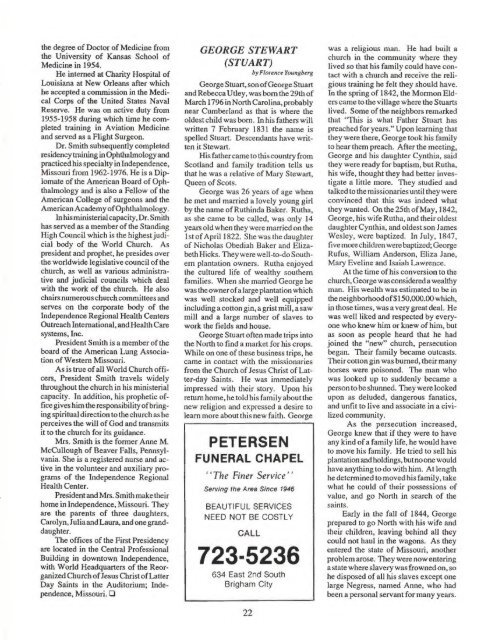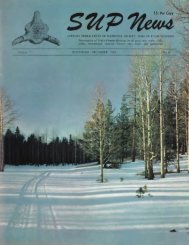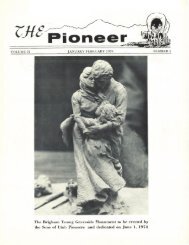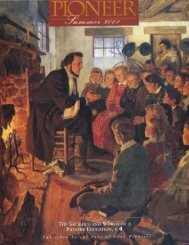Pioneer: 1990 Vol.37 No.6
Create successful ePaper yourself
Turn your PDF publications into a flip-book with our unique Google optimized e-Paper software.
the degree of Doctor of Medicine from<br />
the University of Kansas School of<br />
Medicine in 1954.<br />
He interned at Charity Hospital of<br />
Louisiana at New Orleans after which<br />
he accepted a commission in the Medi¬<br />
cal Corps of the United States Naval<br />
Reserve. He was on active duty from<br />
1955-1958 during which time he com¬<br />
pleted training in Aviation Medicine<br />
and served as a Flight Surgeon.<br />
Dr. Smith subsequently completed<br />
residency training in Ophthalmology and<br />
practiced his specialty in Independence,<br />
Missouri from 1962-1976. He is a Diplomate<br />
of the American Board of Oph¬<br />
thalmology and is also a Fellow of the<br />
American College of surgeons and the<br />
American Academy of Ophthalmology.<br />
In his ministerial capacity, Dr. Smith<br />
has served as a member of the Standing<br />
High Council which is the highest judi¬<br />
cial body of the World Church. As<br />
president and prophet, he presides over<br />
the worldwide legislative council of the<br />
church, as well as various administra¬<br />
tive and judicial councils which deal<br />
with the work of the church. He also<br />
chairs numerous church committees and<br />
serves on the corporate body of the<br />
Independence Regional Health Centers<br />
Outreach International, and Health Care<br />
systems, Inc.<br />
President Smith is a member of the<br />
board of the American Lung Associa¬<br />
tion of Western Missouri.<br />
As is true of all World Church offi¬<br />
cers, President Smith travels widely<br />
throughout the church in his ministerial<br />
capacity. In addition, his prophetic of¬<br />
fice gives him the responsibility of bring¬<br />
ing spiritual direction to the church as he<br />
perceives the will of God and transmits<br />
it to the church for its guidance.<br />
Mrs. Smith is the former Anne M,<br />
McCullough of Beaver Falls, Pennsyl¬<br />
vania. She is a registered nurse and ac¬<br />
tive in the volunteer and auxiliary pro¬<br />
grams of the Independence Regional<br />
Health Center.<br />
President and Mrs. Smith make their<br />
home in Independence, Missouri. They<br />
are the parents of three daughters,<br />
Carolyn, Julia and Laura, and one grand¬<br />
daughter.<br />
The offices of the First Presidency<br />
are located in the Central Professional<br />
Building in downtown Independence,<br />
with World Headquarters of the Reor¬<br />
ganized Church of Jesus Christ of Latter<br />
Day Saints in the Auditorium; Inde¬<br />
pendence, Missouri. □<br />
GEORGE STEWART<br />
(STUART)<br />
by Florence Youngberg<br />
George Stuart, son of George Stuart<br />
and Rebecca Utley, was bom the 29th of<br />
March 1796 in North Carolina, probably<br />
near Cumberland as that is where the<br />
oldest child was born. In his fathers will<br />
written 7 February 1831 the name is<br />
spelled Stuart. Descendants have writ¬<br />
ten it Stewart.<br />
His father came to this country from<br />
Scotland and family tradition tells us<br />
that he was a relative of Mary Stewart,<br />
Queen of Scots.<br />
George was 26 years of age when<br />
he met and married a lovely young girl<br />
by the name of Ruthinda Baker. Rutha,<br />
as she came to be called, was only 14<br />
years old when they were married on the<br />
1st of April 1822. She was the daughter<br />
of Nicholas Obediah Baker and Eliza¬<br />
beth Hicks. They were well-to-do South¬<br />
ern plantation owners. Rutha enjoyed<br />
the cultured life of wealthy southern<br />
families. When she married George he<br />
was the owner of a large plantation which<br />
was well stocked and well equipped<br />
including a cotton gin, a grist mill, a saw<br />
mill and a large number of slaves to<br />
work the fields and house.<br />
George Stuart often made trips into<br />
the North to find a market for his crops.<br />
While on one of these business trips, he<br />
came in contact with the missionaries<br />
from the Church of Jesus Christ of Lat¬<br />
ter-day Saints. He was immediately<br />
impressed with their story. Upon his<br />
return home, he told his family about the<br />
new religion and expressed a desire to<br />
leam more about this new faith. George<br />
PETERSEN<br />
FUNERAL CHAPEL<br />
“The Finer Service’’<br />
Serving the Area Since 1946<br />
BEAUTIFUL SERVICES<br />
NEED NOT BE COSTLY<br />
CALL<br />
723-5236<br />
634 East 2nd South<br />
Brigham City<br />
22<br />
was a religious man. He had built a<br />
church in the community where they<br />
lived so that his family could have con¬<br />
tact with a church and receive the reli¬<br />
gious training he felt they should have.<br />
In the spring of 1842, the Mormon Eld¬<br />
ers came to the village where the Stuarts<br />
lived. Some of the neighbors remarked<br />
that “This is what Father Stuart has<br />
preached for years.” Upon learning that<br />
they were there, George took his family<br />
to hear them preach. After the meeting,<br />
George and his daughter Cynthia, said<br />
they were ready for baptism, but Rutha,<br />
his wife, thought they had better inves¬<br />
tigate a little more. They studied and<br />
talked to the missionaries until they were<br />
convinced that this was indeed what<br />
they wanted. On the 25th of May, 1842,<br />
George, his wife Rutha, and their oldest<br />
daughter Cynthia, and oldest son James<br />
Wesley, were baptized. In July, 1847,<br />
five more children were baptized; George<br />
Rufus, Wiliiam Anderson, Eliza Jane,<br />
Mary Eveline and Isaiah Lawrence.<br />
At the time of his conversion to the<br />
church, George was considered a wealthy<br />
man. His wealth was estimated to be in<br />
the neighborhood of $150,000.00 which,<br />
in those times, was a very great deal. He<br />
was well liked and respected by every¬<br />
one who knew him or knew of him, but<br />
as soon as people heard that he had<br />
joined the “new” church, persecution<br />
began. Their family became outcasts.<br />
Their cotton gin was burned, their many<br />
horses were poisoned. The man who<br />
was looked up to suddenly became a<br />
person to be shunned. They were looked<br />
upon as deluded, dangerous fanatics,<br />
and unfit to live and associate in a civi¬<br />
lized community.<br />
As the persecution increased,<br />
George knew that if they were to have<br />
any kind of a family life, he would have<br />
to move his family. He tried to sell his<br />
plantation and holdings, but no one would<br />
have anything to do with him. At length<br />
he determined to moved his family, take<br />
what he could of their possessions of<br />
value, and go North in search of the<br />
saints.<br />
Early in the fall of 1844, George<br />
prepared to go North with his wife and<br />
their children, leaving behind all they<br />
could not haul in the wagons. As they<br />
entered the state of Missouri, another<br />
problem arose. They were now entering<br />
a state where slavery was frowned on, so<br />
he disposed of all his slaves except one<br />
large Negress, named Anne, who had<br />
been a personal servant for many years.







